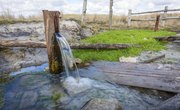
Rivers, streams, ponds, lakes and swamps may seem full of water, but they hold only 3 percent of the planet's entire freshwater; 30 percent of that freshwater lies under the ground. Because life on Earth needs freshwater to survive, it's important to find, use and maintain surface and subsurface water sources efficiently and wisely.
Water Resource Definitions
Surface water isn't simply water sitting in a pond, lake or river. The Arizona Department of Water Resources classifies surface water as water from all sources, whether it flows in canyons, streams or ravines. It doesn't matter if it is floodwater or wastewater. Subsurface water, also called groundwater, fills the spaces in geologic strata and soils underground.
Surface Water Sources
Precipitation replenishes streams, rivers and other surface water resources. When precipitation falls, it becomes runoff if it doesn't seep into the ground. Watersheds are land areas that drain water into surface water resources. The Mississippi River, for instance, gets its water from thousands of small watersheds that surround it.
Subsurface Water Sources
Precipitation replenishes subsurface water through a process called recharging. About 10 to 20 percent of that precipitation winds up in aquifers. An aquifer is a layer of rock that holds water. Recharging usually happens during the winter in temperate climates and in tropical climates when the rainy season arrives. Subsurface water can flow to the surface if the atmospheric pressure above ground is lower than the subsurface water pressure.
Other Subsurface Water Benefits
Subsurface water contributes to the flow of rivers and streams and provides most rural populations with drinking water they get from domestic wells. This type of water is especially important in arid areas where no surface water exists. Subsurface water also helps sustain the farming industry by providing much of the water needed for irrigation.
Finding Hidden Water Resources
Lakes, rivers and other water sources above ground also provide recreation for people and alternative ways to travel. While these water resources are visible, you may not know when a large subsurface resource is below you. Hydrologists analyze rocks in an area to see if that area could have water underground. They also test existing wells in a location to determine important measurements such as the rate water moves through aquifers. Sometimes the presence of certain types of plants provides clues that water could lie underground.
References
- U.S. Environmental Protection Agency: Water Trivia Facts | Drinking Water
- U.S. Geological Survey: What is Ground Water?
- Encyclopedia Britannica Groundwater (hydrology)
- National Atlas.gov: Surface Water
- U.S. Geological Survey: Sustainability of Ground-Water Resources
- U.S. Geological Survey: How Do Hydrologists Locate Groundwater?
About the Author
After majoring in physics, Kevin Lee began writing professionally in 1989 when, as a software developer, he also created technical articles for the Johnson Space Center. Today this urban Texas cowboy continues to crank out high-quality software as well as non-technical articles covering a multitude of diverse topics ranging from gaming to current affairs.
Photo Credits
Karl Weatherly/Digital Vision/Getty Images
